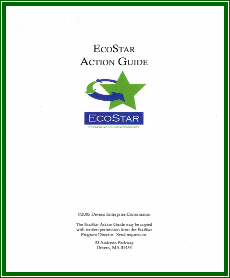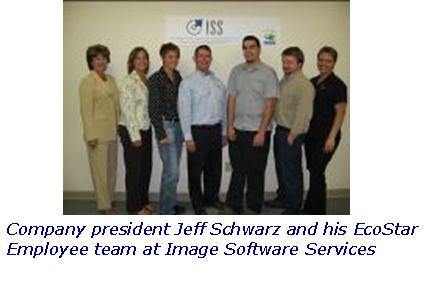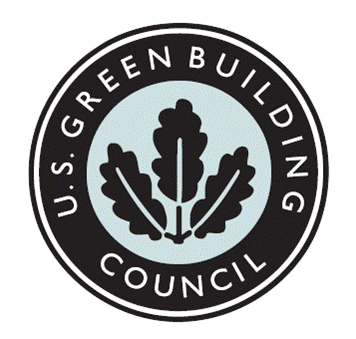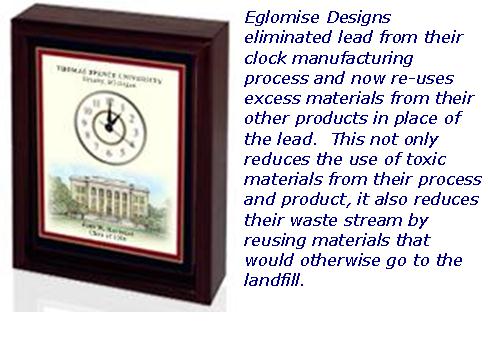Summary of Standards
 Each Member receives a copy of the EcoStar Action Guide – a comprehensive manual that guides participants through each of the 25 performance standards. For each standard, the manual provides a description of the purpose and benefits, how to document and achieve the standard and provides users with a list of relevant references and resources to help organizations see what other businesses are doing to meet these standards. The following is a brief summary of each Standard:
Each Member receives a copy of the EcoStar Action Guide – a comprehensive manual that guides participants through each of the 25 performance standards. For each standard, the manual provides a description of the purpose and benefits, how to document and achieve the standard and provides users with a list of relevant references and resources to help organizations see what other businesses are doing to meet these standards. The following is a brief summary of each Standard:
Standard 1 – Environmental Vision and Policy Statement: Developing a clear and concise environmental vision for your organization that employees support and understand will provide the direction and motivation needed to achieve your commitment to environmental leadership. The guide walks you through step by step on how to develop a clear vision and goals and encourages participation of all employees to raise awareness and gain support.
Standard 2 – EcoStar Coordinator and Employee Team: This standard advises members to appoint an EcoStar team and leader to represent your organization and facilitate team efforts for working towards meeting your organization’s environmental vision developed in Standard 1. Building a team representing different aspects of your organization is key to successful achievement of this standard and getting the entire organization’s support for your environmental vision and policy.
Standard 3 – Annual Assessment and Goal Setting for Continuous Environmental Improvement: Once you have a clear vision and have organized a team to achieve it, the next step is to begin working towards improving the environmental performance and operating efficiency within your organization. This standard advises participants to conduct an annual assessment of material inputs (i.e., energy and water consumption, materials purchased) and outputs (i.e., solid and liquid waste, hazardous waste, air emissions, by-products and final products). Understanding how operations currently function aids in the identification of ways to minimize waste and increase resource efficiency, to not only reduce overall environmental impact but also provide your organization with operating cost savings.
 Standard 4 – Employee Training and Involvement in EcoStar: As the previous standards stress, management and employee education, buy-in and commitment is essential to the success of the EcoStar program. This standard requires participants to develop at least three incentives and/or training opportunities that encourage interaction with management and staff in participating in the EcoStar program. The EcoStar Action Guide recommends types of training and provides ideas for recognition and reward incentives to attract employees and keep them interested in the program.
Standard 4 – Employee Training and Involvement in EcoStar: As the previous standards stress, management and employee education, buy-in and commitment is essential to the success of the EcoStar program. This standard requires participants to develop at least three incentives and/or training opportunities that encourage interaction with management and staff in participating in the EcoStar program. The EcoStar Action Guide recommends types of training and provides ideas for recognition and reward incentives to attract employees and keep them interested in the program.
Standard 5 – Business Linkages to Improve Efficiency: Many businesses produce wastes and by-products that other organizations may be able to use. Similarly, many businesses within close proximity to one another require the same services and resources and thus can benefit from the cost savings and reduced environmental impacts by ordering in bulk or sharing services. Organizations can use the information generated from completing Standard 3 (inputs and outputs inventory) to initiate discussions and interactions between businesses and organizations working towards achievement of this standard.
Standard 6 – Involve Suppliers: Encouraging your organization’s suppliers to adopt similar sustainable business practices, such as purchasing only environmentally sound products and services (toxics use reduction), can have a tremendous impact on the sustainability of your operations and is the basis of this standard. The more sustainable your inputs (products and services) are, the more sustainable your organization and its outputs become. In this manner, both you and your suppliers ultimately reap the benefits of sustainable business practices.
Standard 7 – Educate Customers: Informing your customers of your participation in the EcoStar program and your commitment to efficiency and sustainability allows you share your knowledge and resources gained through EcoStar and promote your organization for its environment responsibility and awareness. The EcoStar program offers participants access to a library of resources including articles, case studies and examples that can assist you in achieving this and other standards.
 Standard 8 – Share Information with the Community: This standard encourages participants to expand their education and information sharing efforts into the local community. Sharing information with the community on your commitment to improve efficiency, reducing pollution and the use of toxic chemicals, helps promote your business as being environmentally responsible. This not only invites community interaction, it helps businesses build local knowledge and trust regarding their practices – offering the community a model of environmental leadership in business. The guide provides participants with excellent resources and ideas for developing community outreach programs.
Standard 8 – Share Information with the Community: This standard encourages participants to expand their education and information sharing efforts into the local community. Sharing information with the community on your commitment to improve efficiency, reducing pollution and the use of toxic chemicals, helps promote your business as being environmentally responsible. This not only invites community interaction, it helps businesses build local knowledge and trust regarding their practices – offering the community a model of environmental leadership in business. The guide provides participants with excellent resources and ideas for developing community outreach programs.
Standard 9 – Water Conservation: As the cost of clean water continues to rise, more efficient use makes not only environmental sense but also economic sense. To achieve this standard, participants are advised to practice and document water conservation in at least three ways. Fixing leaks, process re-design, reuse of water, installation of water saving devices and low-impact landscaping are just a few of the ways businesses can achieve this standard. EcoStar participants can use information gathered from their annual assessment of inputs and outputs (Standard 3) to help analyze ways of reducing water use.
Standard 10 – Energy Efficiency and Conservation: Improving efficiency of your operations and reducing the amount of energy used saves both time and money. This standard requires participants to practice energy efficiency and conservation in at least three ways. The EcoStar Action guide and resources helps walk users through the development of a conservation action plan to implement and document cost-saving efficiency measures.
 Standard 11 – Green Building Design: Carefully applied design principles and building upgrades and maintenance can reduce operating costs, energy and water use, as well as raise the comfort, health and productivity of occupants within the building. Participants can meet “green” building design and construction standards through the LEED rating system (Leadership in Energy and Environmental Design). The LEED rating system provides a complete framework for assessing building performance, improving occupant well-being, reducing environmental impacts and increasing economic returns. The EcoStar Action Guide and library provides participants with an abundance of resources to aid in achievement of this standard.
Standard 11 – Green Building Design: Carefully applied design principles and building upgrades and maintenance can reduce operating costs, energy and water use, as well as raise the comfort, health and productivity of occupants within the building. Participants can meet “green” building design and construction standards through the LEED rating system (Leadership in Energy and Environmental Design). The LEED rating system provides a complete framework for assessing building performance, improving occupant well-being, reducing environmental impacts and increasing economic returns. The EcoStar Action Guide and library provides participants with an abundance of resources to aid in achievement of this standard.
Standard 12 – Toxics Use Reduction: This standard explains how participants can assess their current level of toxic and hazardous materials use and implement a plan to reduce and/or eliminate their need or use. With the advancements in science and technology, many of the hazardous materials used in today’s operations and processes are being replaced by more environmentally friendly products. The goal is to improve environmental health and safety for workers and the community, while also reducing the operation costs associated with transportation, storage and disposal of toxic and hazardous materials. The EcoStar program requires participants to establish a team to inventory existing uses, identify toxic use reduction opportunities and develop a plan for implementation.
Standard 13 – Material Reuse: Often, materials used or generated in a business can be re-used a number of times for the same purpose or for a new purpose before they become unusable waste. In addition, waste, materials and/or by-products from one business may be usable by another business or organization. To achieve this standard, participants develop and document at least three examples of material re-use. The guide provides examples and like other standards, encourages participants to engage their employees in working towards the development of ways to achieve this standard. This standard provides more opportunities to save money while reducing your overall waste stream and environmental impact.
Standard 14 – Recycling: Diverting waste from landfills and incinerators to provide raw materials for manufacturing and re-manufacturing is the concept behind recycling. This expands on Standard 13 to promote further waste reduction, conservation of natural resources, mitigation of global warming and even local job growth. To achieve this standard, participants must develop and document at least three examples of increased efforts towards recycling and reducing waste. The EcosStar Action Guide provides an eight step program to assist in establishing and expanding your recycling program.
 Standard 15 – Product Design: Designing or redesigning your products and/or services with consideration of impacts on human health and the environment is the basis of this standard. By considering energy use, toxicity of input materials and end-of-life disposal practices, businesses can work towards decreasing the overall environmental impacts and financial costs associated with production. To begin applying these “design for the environment” principles in your business, a life-cycle assessment of the environmental impacts associated with your products and/or services should be undertaken. The EcoStar Action Guide outlines a life-cycle assessment that can assist you in developing an implementation plan for incorporating “design for the environment” strategies into your products and/or services.
Standard 15 – Product Design: Designing or redesigning your products and/or services with consideration of impacts on human health and the environment is the basis of this standard. By considering energy use, toxicity of input materials and end-of-life disposal practices, businesses can work towards decreasing the overall environmental impacts and financial costs associated with production. To begin applying these “design for the environment” principles in your business, a life-cycle assessment of the environmental impacts associated with your products and/or services should be undertaken. The EcoStar Action Guide outlines a life-cycle assessment that can assist you in developing an implementation plan for incorporating “design for the environment” strategies into your products and/or services.
Standard 16 – Packaging: Developing and implementing strategies to eliminate, reduce or re-use packaging can save time and improve efficiency, while further reducing your waste stream and material costs. This standard encourages businesses to look for ways to simplify packaging with less material, incorporate recycled content, eliminate toxic constituents and use packaging that can be re-used and/or recycled. This helps you meet your environmental goals and lower waste disposal costs for your customers.
Standard 17 – Environmentally Preferable Purchasing: Purchasing that prioritizes factors such as recycled content, resource conservation, waste prevention, renewable and non-toxic materials, minimal packaging and reduced transportation/shipping may increase buying efficiency and reduce impacts on human health and the environment. To achieve this standard, participants demonstrate that they have purchased at least three environmentally friendly products and services. Using the communications developed in Standard 6, participants can work closely with existing or new suppliers and/or products that meet the goals of the EcoStar program. Again, as an example and reference, Massachusetts has one of the most extensive and successful environmentally preferred purchasing programs in the country for state agencies.
Standard 18 – Ecological Landscaping: Alterations to the soil, water and vegetation on your property can weaken the health and sustainability of your grounds and the surrounding lands. This standard promotes the use of landscaping practices that have less impact on soil quality, conserve water and preserve surrounding biodiversity. Participants are encouraged to implement ecologically sustainable landscape practices on their property. Some examples include composting applications (reducing or eliminating the need for chemical fertilizers and pesticides); minimization of lawn areas (habitat, stormwater and aesthetic benefits); xeriscaping (plantings that require less water); and the use of native plants (preserving biodiversity and habitat). This standard continues to expand on the networking concept promoted throughout the EcoStar program, by involving your current landscaper or maintenance company in sustainable development practices.
Standard 19 – Create Corridor or Habitat for Local Wildlife: The grasslands, meadows, wetlands, streams, forests and floodplains within Devens and the surrounding communities contain an abundance of wildlife and biodiversity. As development intrudes into the natural landscape, wildlife becomes displaced. The goal of this standard is to preserve and restore biodiversity on your property. This expands on Standard 18 and encourages participants to add wildlife habitat where feasible and practical. Participants can work towards habitat restoration on their property or assist others to meet the requirements of this standard.
Standard 20 – Equipment Maintenance: Like a regular tune up for your car, proper equipment maintenance not only improves overall operations efficiency and safety, it also helps reduce waste, emissions and potential spills/leaks. Effective operations and maintenance further meets the objectives of the EcoStar program by reducing energy costs, requiring fewer service calls and extending the life of equipment. Developing a scheduled maintenance plan, reviewing and updating maintenance documentation, assessing existing operations and maintenance and identifying deficiencies and priorities are just some of the steps the EcoStar program guides you through to achieve this standard.
Standard 21 – Involvement with Community Environmental Projects: This standard encourages you and your business to support and interact further with the local community in environmental education and improvement projects. Developing partnerships within the local community helps strengthen the trust and respect for your business and provides mutual benefits to you, the community and the environment. A six-step process in the EcoStar Action Guide assists participants in achieving this standard.
Standard 22 – Transportation: With more Americans driving more than ever, coupled with the rising costs of fuel and impacts on air quality, human health, global warming and the environment, this standard encourages participants to reduce individual vehicle miles traveled through carpooling and improved options for public transportation. The guide provides examples of a number of incentives that employers can offer their employees to encourage participation in rid-sharing and public transportation options.
 Standard 23 – Business to Business Mentoring: Being an EcoStar member enables your business to develop a knowledge base that can be extremely valuable to other businesses and organizations that are in the process of or want to achieve the same benefits. Expanding on Standard 5 (Business Linkages to Improve Efficiency), this standard encourages businesses and organizations to share their experiences and knowledge gained through the EcoStar program. Providing mentoring assistance to other businesses creates mutually beneficial relationships and networking opportunities. This also allows larger organizations with more staff and resources, to assist smaller organizations that may not have the same level of resources.
Standard 23 – Business to Business Mentoring: Being an EcoStar member enables your business to develop a knowledge base that can be extremely valuable to other businesses and organizations that are in the process of or want to achieve the same benefits. Expanding on Standard 5 (Business Linkages to Improve Efficiency), this standard encourages businesses and organizations to share their experiences and knowledge gained through the EcoStar program. Providing mentoring assistance to other businesses creates mutually beneficial relationships and networking opportunities. This also allows larger organizations with more staff and resources, to assist smaller organizations that may not have the same level of resources.
Standard 24 – Climate Change Mitigation: This standard promotes actions that your business can take to reduce contributions to global warming. Many of the previous standards already work towards meeting this standard (Transportation, Green Building Design, Improved Efficiency in Operations). Three additional measures that this standard encourages are documenting and reducing the overall emissions of your business; offsetting emissions through investment in forest resources, or; find other means of offsetting emissions, such as community emission reduction assistance (identifying a partner facility in your community and assisting them in reducing or offsetting emissions).
Standard 25 – Create Your Own Standard: The EcoStar program encourages participants to be innovative and creative in their attempts to gain ‘EcoStar Achiever’ status. This standard provides flexibility to participating organizations to address a particular issue is unique to your business or that may not be covered by Standards 1 through 24.